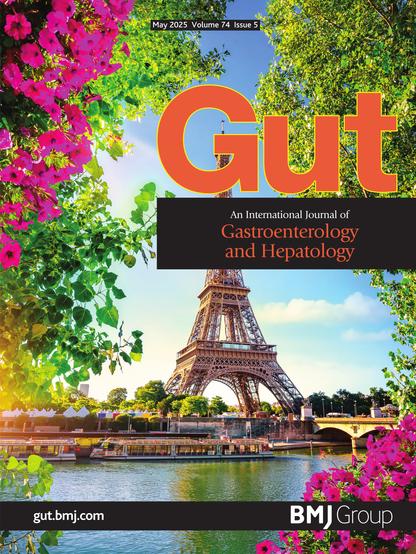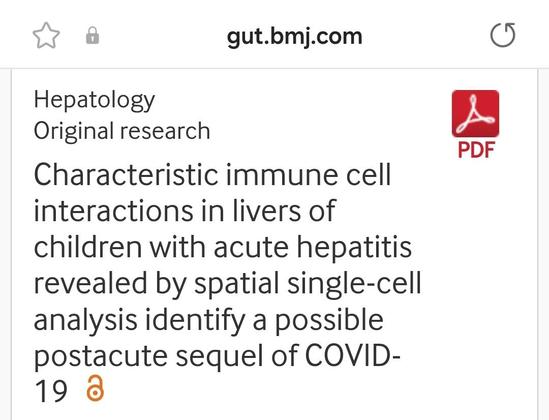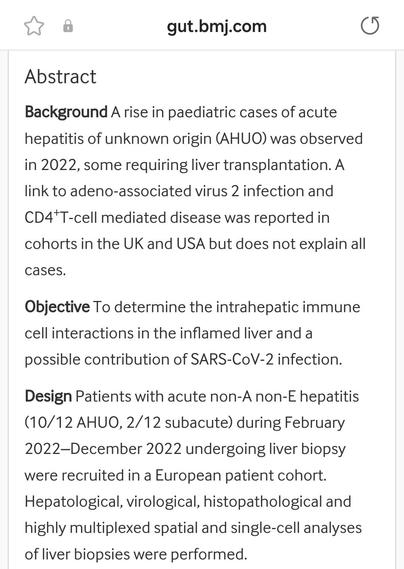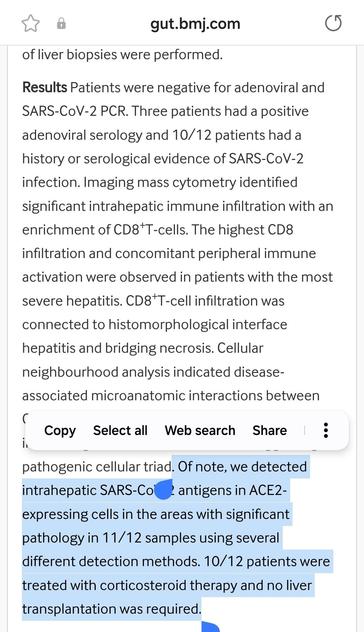@ChristosArgyrop The world decided before knowing what the long term consequences of COVID-19 infections might be that it was "just the flu."
It isn't "just the flu."
(And yes, the flu is also really bad and people shouldn't be allowed to treat it as if it was completely harmless, but this is literally 100 times worse just in immediate consequences and even more so in long term consequences.)
We're finding out more and more that it has consequences beyond just the stuff we knew early on.
Pretty sure a number of people raised this but were accused of fearmongering.
Article: https://doi.org/10.1136/gutjnl-2024-333880
PubMed entry: https://pubmed.ncbi.nlm.nih.gov/40187893/

Characteristic immune cell interactions in livers of children with acute hepatitis revealed by spatial single-cell analysis identify a possible postacute sequel of COVID-19
Background A rise in paediatric cases of acute hepatitis of unknown origin (AHUO) was observed in 2022, some requiring liver transplantation. A link to adeno-associated virus 2 infection and CD4+T-cell mediated disease was reported in cohorts in the UK and USA but does not explain all cases. Objective To determine the intrahepatic immune cell interactions in the inflamed liver and a possible contribution of SARS-CoV-2 infection. Design Patients with acute non-A non-E hepatitis (10/12 AHUO, 2/12 subacute) during February 2022–December 2022 undergoing liver biopsy were recruited in a European patient cohort. Hepatological, virological, histopathological and highly multiplexed spatial and single-cell analyses of liver biopsies were performed. Results Patients were negative for adenoviral and SARS-CoV-2 PCR. Three patients had a positive adenoviral serology and 10/12 patients had a history or serological evidence of SARS-CoV-2 infection. Imaging mass cytometry identified significant intrahepatic immune infiltration with an enrichment of CD8+T-cells. The highest CD8 infiltration and concomitant peripheral immune activation were observed in patients with the most severe hepatitis. CD8+T-cell infiltration was connected to histomorphological interface hepatitis and bridging necrosis. Cellular neighbourhood analysis indicated disease-associated microanatomic interactions between CX3CR1+ endothelial and myeloid cell populations, interacting with effector CD8+T-cells suggesting a pathogenic cellular triad. Of note, we detected intrahepatic SARS-CoV-2 antigens in ACE2-expressing cells in the areas with significant pathology in 11/12 samples using several different detection methods. 10/12 patients were treated with corticosteroid therapy and no liver transplantation was required. Conclusions We identified a possible manifestation of an immune-mediated postacute sequel to COVID-19 associated with a characteristic immune infiltrate in children with AHUO. COVID-19 testing should be considered in paediatric AHUO. Data are available in a public, open access repository. The imaging data and high-resolution versions of the figures illustrating IMC data are available at zenondo.org (reference: 40) 10.5281/zenodo.14097945. The clinical data isare listed in tables in this manuscript.
@lffontenelle @ChristosArgyrop The previous work on this is described at:
* https://www.medrxiv.org/content/10.1101/2022.07.19.22277425v1

Adeno-associated virus 2 infection in children with non-A-E hepatitis
An outbreak of acute hepatitis of unknown aetiology in children was first reported in Scotland in April 2022.[1][1] Cases aged <16 years have since been identified in 35 countries.[2][2] Here we report a detailed investigation of 9 early cases and 58 control subjects. Using next-generation sequencing and real-time PCR, adeno-associated virus 2 (AAV2), was detected in the plasma of 9/9 and liver of 4/4 patients but in 0/13 sera/plasma of age-matched healthy controls, 0/12 children with adenovirus (HAdV) infection and normal liver function and 0/33 children admitted to hospital with hepatitis of other aetiology. AAV2 typically requires a coinfecting ‘helper’ virus to replicate, usually HAdV or a herpesvirus. HAdV (species C and F) and human herpesvirus 6B (HHV6B) were detected in 6/9 and 3/9 affected cases, including 3/4 and 2/4 liver biopsies, respectively. The class II HLA-DRB1*04:01 allele was identified in 8/9 cases (89%), compared with a background frequency of 15.6% in Scottish blood donors, suggestive of increased susceptibility in affected cases. Acute non-A-E paediatric hepatitis is associated with the presence of AAV2 infection, which could represent a primary pathogen or a useful biomarker of recent HAdV or HHV6B infection. Population and mechanistic studies are required to explore these findings further. ### Competing Interest Statement The authors have declared no competing interest. ### Funding Statement The work was funded by Public Health Scotland and the National Institute for Health Research (NIHR award COCIN01) and the Medical Research Council (MRC grants MC\_UU\_1201412, MC\_PC\_19059 & MC\_PC\_22004). DIAMONDS is funded by the European Union Horizon 2020 programme grant 848196). ### Author Declarations I confirm all relevant ethical guidelines have been followed, and any necessary IRB and/or ethics committee approvals have been obtained. Yes The details of the IRB/oversight body that provided approval or exemption for the research described are given below: All patients (cases and controls) were recruited with the informed written consent of parents or guardians. Ethical approval was given for the recruitment of cases by the South Central Oxford C Research Ethics Committee in England (13/SC/0149), the Scotland A Research Ethics Committee (20/SS/0028), and the WHO Ethics Review Committee (RPC571 and RPC572) for the International Severe Acute Respiratory and Emerging Infections Consortium (ISARIC) WHO Clinical Characterisation Protocol UK (CCPUK). Control samples were obtained from the Diagnosis and Management of Febrile Illness using RNA Personalised Molecular Signature Diagnosis study cohort (DIAMONDS). The DIAMONDS study was approved by the London Dulwich Research Ethics Committee (20/HRA/1714). I confirm that all necessary patient/participant consent has been obtained and the appropriate institutional forms have been archived, and that any patient/participant/sample identifiers included were not known to anyone (e.g., hospital staff, patients or participants themselves) outside the research group so cannot be used to identify individuals. Yes I understand that all clinical trials and any other prospective interventional studies must be registered with an ICMJE-approved registry, such as ClinicalTrials.gov. I confirm that any such study reported in the manuscript has been registered and the trial registration ID is provided (note: if posting a prospective study registered retrospectively, please provide a statement in the trial ID field explaining why the study was not registered in advance). Yes I have followed all appropriate research reporting guidelines and uploaded the relevant EQUATOR Network research reporting checklist(s) and other pertinent material as supplementary files, if applicable. Yes All data produced in the present study are available upon reasonable request to the authors, other than patient-specific data that cannot be released for reasons of confidentiality under the relevant ethical approvals. [1]: #ref-1 [2]: #ref-2
- They didn't check for strawberry adenodog antigens
- We were told it's very difficult to get pediatric blood samples (I don't know how many will remember this one); how could they possibly get liver samples?
- It was already decided years ago that nuh-uh, it couldn't be the C-word




